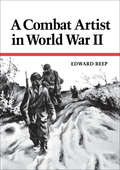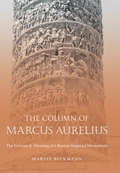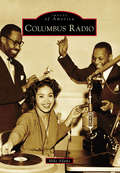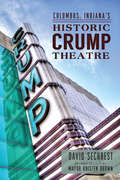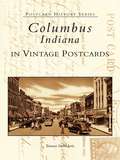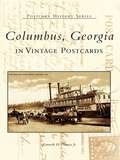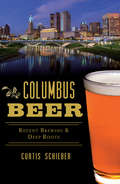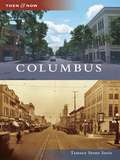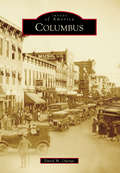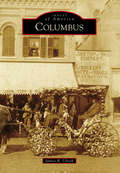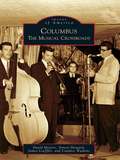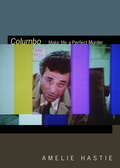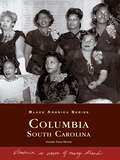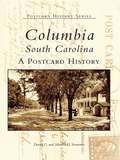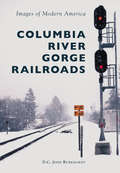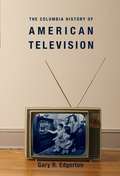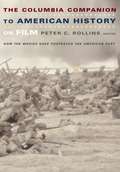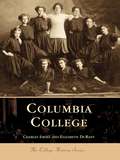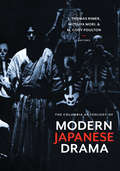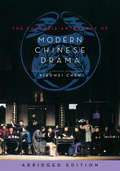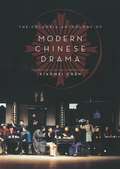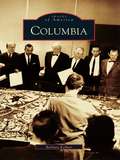- Table View
- List View
A Combat Artist in World War II
by Edward ReepMany artists have fought in wars, and renowned painters have recorded heroic scenes of great battles, but those works were usually done long after the battles were waged. Artists have also been commissioned to visit, briefly, war-torn areas and make notes
The Column of Marcus Aurelius
by Martin BeckmannOne of the most important monuments of Imperial Rome and at the same time one of the most poorly understood, the Column of Marcus Aurelius has long stood in the shadow of the Column of Trajan. InThe Column of Marcus Aurelius, Martin Beckmann makes a thorough study of the form, content, and meaning of this infrequently studied monument. Beckmann employs a new approach to the column, one that focuses on the process of its creation and construction, to uncover the cultural significance of the column to the Romans of the late second century A. D. Using clues from ancient sources and from the monument itself, this book traces the creative process step by step from the first decision to build the monument through the processes of planning and construction to the final carving of the column's relief decoration. The conclusions challenge many of the widely held assumptions about the value of the column's 700-foot-long frieze as a historical source. By reconstructing the creative process of the column's sculpture, Beckmann opens up numerous new paths of analysis not only to the Column of Marcus Aurelius but to Roman imperial art and architecture in general.
Columbus Radio (Images of America)
by Mike AdamsTwo professors and a preacher invented Columbus radio. It began with science experiments in classrooms and a minister's desire to expand beyond his churchgoing audience. By 1922, government licenses had been issued for WEAO at Ohio State University and WJD at Denison University. At this same time, a Baptist minister went on the air for an hour each Sunday morning using a 10-watt transmitter licensed as WMAN. In this story of Columbus radio, the work of the professors and the preacher will evolve into radio with advertiser-supported programs of information and entertainment. Three important radio stations will serve a growing Columbus radio audience in different ways: WEAO becomes WOSU, a national pioneer in using radio for teaching; WMAN becomes WCOL and in the 1960s is number one in audience size; and CBS affiliate WBNS becomes the class act of Columbus radio, retaining the major share of local listeners for many decades. Including many other stations of lesser influence, the illustrated stories of Columbus radio are told in this book.
Columbus Indiana's Historic Crump Theatre (Landmarks)
by David SechrestNot since the construction of the Columbus courthouse had one man and his vision received as much publicity from local newspapers as John Crump and his theater, designed and built by architect Charles Sparrell in 1889. This is the story of the passion, struggles and triumphs that created the first true cultural arts center in this small town and the legacy that continues to inspire the community over a century later to protect this local landmark. It is a journey marked by first-class opera performances, flickering silent films, police intervention and arrests and, ultimately, decay and closure. A portion of the proceeds from sales of this book will go to the Heritage Fund in support of the Crump Theatre building--an architectural treasure in a city that boasts many.
Columbus, Indiana in Vintage Postcards
by Tamara Stone IorioFounded in 1821, Columbus, Indiana, had grown into a thriving manufacturing region by the end of the 19th century. Columbus might have remained a community like most other small towns, but a group of citizens with an extraordinary vision developed a program to bring world-renowned architects to the city. Beginning in the mid-20th century, Columbus was transformed into a center of modern architecture--ranked sixth in the United States in architectural innovation by the American Institute of Architects (after Chicago, New York, Washington, San Francisco, and Boston). This collection of more than 200 vintage postcards features some of Columbus's earliestimportant buildings and its later architectural gems.
Columbus, Georgia in Vintage Postcards (Postcard History)
by Kenneth H. Thomas Jr.Founded in 1828 as a planned city by the Georgia Legislature, Columbus prospered due to its location on the Chattahoochee River. Industry sprang up along the shores of the Chattahoochee and shaped Columbus's identity as one of Georgia's premier cities. Today a thriving metropolis, it is the Columbus of yesteryear that is illuminated within these pages. Early postcard views reflect the city from around 1905 to 1942, showcasing many of its businesses, neighborhoods, and parks. Included are places virtually unknown to citizens today--the Bell Tower, the City Market, North Highlands Park, and Wildwood Park--as well as those that were landmarks a century ago and landmarks still: the Iron Bank, the Springer Opera House, the Union Depot, the YMCA, and Fort Benning.
Columbus Beer: Recent Brewing and Deep Roots (American Palate)
by Curt SchieberBrewing in Columbus began more than two centuries ago. The taps were only turned off during Prohibition and the short pause that preceded the modern craft beer explosion. For generations, names such as Hoster, Born, Schlee and Wagner secured staunch local loyalty for their brands and earned national acclaim for their brewmasters. Today, more than thirty craft breweries ply a prosperous trade in the capital city. After huge California craft brewery Stone became serious about Columbus for its East Coast expansion, Scotland's successful BrewDog chose central Ohio for its U.S. beachhead. Author Curtis Schieber celebrates the rise, fall and triumphant return of brewing in Ohio’s capital.
Columbus
by Tamara Stone IorioSince its founding in 1821, Columbus, Indiana, has changed greatly--from an early agricultural town to a small modern city with varied business and industry. Today Columbus is most famous for its architectural gems from the past half century, but many historic buildings from early Columbus still exist. As Columbus has changed, its buildings have changed as well. Tamara Stone Iorio is a pediatrician and longtime resident of Columbus with an interest in history and writing.
Columbus
by David M. OwingsColumbus has been uniquely positioned to take advantage of booming industry and trade throughout its history. Established in 1828 on the fall line of the Chattahoochee River, where the Piedmont Plateau meets the Coastal Plain, Columbus owes much of its success to the river; yet, there is much more to the city and its identity. Images of America: Columbus uses vintage images to explore the city's past in an effort to capture "what progress has preserved." This photographic collection travels back through time to take an intimate look at how Columbus transformed from a frontier town into the redefined and revitalized city that it has become. These photographs capture businesses, churches, busy street corners, and other city landmarks, as well as more personal glimpses of individuals, families, and homes. By revisiting the heart of the city, readers are offered a chance to easily imagine Columbus's past as if it were still alive today.
Columbus (Images of America)
by Janice R. UlrichFrom the earliest days of Columbus, rural dwellers and city residents have shared a common goal of making the area a comfortable place to call home. The early Welsh and German settlers found fertile soil, lumber, a source of water in the Crawfish River, and generally adequate rainfall to successfully grow crops for their families and to sell for income. They needed little else except their own industrious spirits. With the establishment of the Columbus Canning Company in 1900, the village was transformed into an industrial hub that thrived for the next 75 years. Businesses related to the production of canned peas, corn, pumpkin, tomatoes, and beans flourished, benefiting both growers and processors. Columbus offers a quiet, low-key environment with access to post-secondary education and world-class cultural experiences within an hour's drive.
Columbus: The Musical Crossroads
by Candice Watkins James Loeffler David Meyers Arnett HowardColumbus has long been known for its musicians. Unlike New York, San Francisco, Kansas City, Nashville, or even Cincinnati, however, it has never had a definable "scene." Still, some truly remarkable music has been made in this musical crossroads by the many outstanding musicians who have called it home. Since 1900, Columbus has grown from the 28th- to the 15th-largest city in the United States. During this period, it has developed into a musically vibrant community that has nurtured the talents of such artists as Elsie Janis, Ted Lewis, Nancy Wilson, Rahsaan Roland Kirk, Dwight Yoakam, Bow Wow, and Rascal Flatts. But, in many instances, those who chose to remain at home were as good and, perhaps, even better.
Columbo: Make Me a Perfect Murder (Spin Offs)
by Amelie HastieFor decades, generations of television fans have been enraptured by Lt. Columbo, played by Peter Falk, as he unravels clues to catch killers who believe they are above the law. In her investigation of the 1970s series cocreated by Richard Levinson and William Link, Amelie Hastie explores television history through an emphasis on issues of stardom, authorship, and its interconnections with classical and New Hollywood cinema. Through close textual analysis, attentive to issues of class relations and connections to other work by Falk as well as Levinson and Link, Columbo: Make Me a Perfect Murder sees American television as an intertextual system, from its origins as a commercial broadcast medium to its iterations within contemporary streaming platforms. Ultimately, Hastie argues, in the titular detective’s constant state of learning about cultural trends and media forms, Columbo offers viewers the opportunity to learn with him and, through his tutelage, to become detectives of television itself.
Columbia, South Carolina: A History Of The Waterways (Black America Series)
by Vennie Deas-MooreSouth Carolina's capital city enjoys a strong African-American presence, one that has had considerable influence on the growth and development of Columbia's commerce and culture since the city's creation in the late 1700s. The challenges of the antebellum South, Reconstruction, the Civil Rights era, and even the present have shaped a vibrant and dynamic black community, which supplies a wealth of leaders for the city, state, and nation.
Columbia, South Carolina: A Postcard History (Postcard History Series)
by Martha D. Sennema David C. SennemaWith Columbia, South Carolina: A Postcard History, Dave and Marty Sennema have assembled an unprecedented collection of picture postcards to create a retrospective of the area from the early 1900s through the 1950s. Here you will find dramatic images of businesses, street scenes, hotels, office buildings, and homes. Even morefascinating are the buildings which have, over the years, been recycled and used to house various businesses and educational institutions.
Columbia River Gorge Railroads (Images of Modern America)
by D.C. Jesse BurkhardtThe Columbia River Gorge is a land of scenic wonder, revered by tourists for its beauty and by recreationalists for its fishing, windsurfing, hiking, and rafting. The region is also a major transportation corridor, home to two vital east-west railroad routes: Burlington Northern Santa Fe on the Washington side of the Columbia River and Union Pacific on the Oregon side. Every day, dozens of freight trains--as well as Amtrak passenger trains--snake along on opposite banks of the wide river, and rail operations have become an integral part of the heartbeat of the gorge. The colorful images in this work celebrate the art and magic of the trains that move goods and passengers through this striking, rugged landscape.
The Columbia History of American Television (Columbia Histories of Modern American Life)
by Gary EdgertonTelevision is a form of media without equal. It has revolutionized the way we learn about and communicate with the world and has reinvented the way we experience ourselves and others. More than just cheap entertainment, TV is an undeniable component of our culture and contains many clues to who we are, what we value, and where we might be headed in the future.Media historian Gary R. Edgerton follows the technological developments and increasing cultural relevance of TV from its prehistory (before 1947) to the Network Era (1948-1975) and the Cable Era (1976-1994). He begins with the laying of the first telegraph line in 1844, which gave rise to the idea that images and sounds could be transmitted over long distances. He then considers the remodeling of television's look and purpose during World War II; the gender, racial, and ethnic components of its early broadcasts and audiences; its transformation of postwar America; and its function in the political life of the country. He talks of the birth of prime time and cable, the influence of innovators like Sylvester "Pat" Weaver, Roone Arledge, and Ted Turner, as well as television's entrance into the international market, describing the ascent of such programs as Dallas and The Cosby Show, and the impact these exports have had on transmitting American culture abroad. Edgerton concludes with a discerning look at our current Digital Era (1995-present) and the new forms of instantaneous communication that continue to change America's social, political, and economic landscape. Richly researched and engaging, Edgerton's history tracks television's growth into a convergent technology, a global industry, a social catalyst, a viable art form, and a complex and dynamic reflection of the American mind and character. It took only ten years for television to penetrate thirty-five million households, and by 1983, the average home kept their set on for more than seven hours a day. The Columbia History of American Television illuminates our complex relationship with this singular medium and provides historical and critical knowledge for understanding TV as a technology, an industry, an art form, and an institutional force.
The Columbia History of American Television
by Gary EdgertonTelevision is a form of media without equal. It has revolutionized the way we learn about and communicate with the world and has reinvented the way we experience ourselves and others. More than just cheap entertainment, TV is an undeniable component of our culture and contains many clues to who we are, what we value, and where we might be headed in the future. Media historian Gary R. Edgerton follows the technological developments and increasing cultural relevance of TV from its prehistory (before 1947) to the Network Era (1948-1975) and the Cable Era (1976-1994). He begins with the laying of the first telegraph line in 1844, which gave rise to the idea that images and sounds could be transmitted over long distances. He then considers the remodeling of television's look and purpose during World War II; the gender, racial, and ethnic components of its early broadcasts and audiences; its transformation of postwar America; and its function in the political life of the country. He talks of the birth of prime time and cable, the influence of innovators like Sylvester "Pat" Weaver, Roone Arledge, and Ted Turner, as well as television's entrance into the international market, describing the ascent of such programs as Dallas and The Cosby Show, and the impact these exports have had on transmitting American culture abroad. Edgerton concludes with a discerning look at our current Digital Era (1995-present) and the new forms of instantaneous communication that continue to change America's social, political, and economic landscape. Richly researched and engaging, Edgerton's history tracks television's growth into a convergent technology, a global industry, a social catalyst, a viable art form, and a complex and dynamic reflection of the American mind and character. It took only ten years for television to penetrate thirty-five million households, and by 1983, the average home kept their set on for more than seven hours a day. The Columbia History of American Television illuminates our complex relationship with this singular medium and provides historical and critical knowledge for understanding TV as a technology, an industry, an art form, and an institutional force.
The Columbia Companion to American History on Film: How the Movies Have Portrayed the American Past
by Rollins Peter C. Ed.American history has always been an irresistible source of inspiration for filmmakers, and today, for good or ill, most Americans'sense of the past likely comes more from Hollywood than from the works of historians. In important films such as The Birth of a Nation (1915), Roots (1977), Apocalypse Now (1979), and Saving Private Ryan (1998), how much is entertainment and how much is rooted in historical fact? In The Columbia Companion to American History on Film, more than seventy scholars consider the gap between history and Hollywood. They examine how filmmakers have presented and interpreted the most important events, topics, eras, and figures in the American past, often comparing the film versions of events with the interpretations of the best historians who have explored the topic. Divided into eight broad categories—Eras; Wars and Other Major Events; Notable People; Groups; Institutions and Movements; Places; Themes and Topics; and Myths and Heroes—the volume features extensive cross-references, a filmography (of discussed and relevant films), notes, and a bibliography of selected historical works on each subject. The Columbia Companion to American History on Film is also an important resource for teachers, with extensive information for research or for course development appropriate for both high school and college students.Though each essay reflects the unique body of film and print works covering the subject at hand, every essay addresses several fundamental questions: What are the key films on this topic? What sources did the filmmaker use, and how did the film deviate (or remain true to) its sources? How have film interpretations of a particular historical topic changed, and what sorts of factors—technological, social, political, historiographical—have affected their evolution? Have filmmakers altered the historical record with a view to enhancing drama or to enhance the "truth" of their putative message?
The Columbia Companion to America History on Film
by Peter C. RollinsIn this collection, more than seventy scholars examine how filmmakers have presented and interpreted the most important events, topics, eras, and figures in the American past, often comparing the film versions of events with interpretations by leading historians. Divided into eight broad categories-Eras; Wars and Other Major Events; Notable People; Groups; Institutions and Movements; Places; Themes and Topics; and Myths and Heroes-the volume features extensive filmographies (of discussed and relevant films), notes, and bibliographies of selected historical works and is united by a detailed index.
Columbia College
by Elizabeth Durant Charles IsraelIn 1854, founders of the South Carolina Methodist Conference established an all-female school in Columbia, South Carolina. Known originally as Columbia Female College, today's Columbia College has suffered and survived hardships, faced challenges, and flourished during its almost 150-year history as an institution of higher learning. The college has succeeded in its mission to provide quality liberal arts education for women and has become one of the leading establishments of its kind in the South. Included within these pages are vintage images of the school throughout the past century and a half. The ever-changing physical attributes of the college--classrooms, administration buildings, ornate gates, and dormitories--as well as the students and faculty who helped shape the college into what it is today are commemorated here in both word and image. From the trials of campus fires and the closing of the school during the Civil War to the triumphs of American artist Georgia O'Keeffe's tenure and the receipt of honors such as the prestigious Hesbergh award, Columbia College has emerged as a well-respected school for women.
The Columbia Anthology of Modern Japanese Drama
by Rimer J. Thomas Mori Mitsuya M. Cody PoultonThis anthology is the first to survey the full range of modern Japanese drama and make available Japan's best and most representative twentieth- and early-twenty-first-century works in one volume. It opens with a comprehensive introduction to Meiji-period drama and follows with six chronological sections: "The Age of Taisho Drama"; The Tsukiji Little Theater and Its Aftermath"; "Wartime and Postwar Drama"; "The 1960s and Underground Theater"; "The 1980s and Beyond"; and "Popular Theater," providing a complete history of modern Japanese theater for students, scholars, instructors, and dramatists. The collection features a mix of original and previously published translations of works, among them plays by such writers as Masamune Hakucho (The Couple Next Door), Enchi Fumiko (Restless Night in Late Spring), Morimoto Kaoru (A Woman's Life), Abe Kobo (The Man Who Turned into a Stick), Kara Juro (Two Women), Terayama Shuji (Poison Boy), Noda Hideki (Poems for Sale), and Mishima Yukio (The Sardine Seller's Net of Love). Leading translators include Donald Keene, J. Thomas Rimer, M. Cody Poulton, John K. Gillespie, Mari Boyd, and Brian Powell. Each section features an introduction to the developments and character of the period, notes on the plays' productions, and photographs of their stage performances. The volume complements any study of modern Japanese literature and modern drama in China, Korea, or other Asian or contemporary Western nations.
The Columbia Anthology of Modern Chinese Drama: abridged edition (Weatherhead Books on Asia)
by Xiaomei ChenThis condensed anthology reproduces close to a dozen plays from Xiaomei Chen's well-received original collection, The Columbia Anthology of Modern Chinese Drama, along with her critical introduction to the historical, cultural, and aesthetic evolution of twentieth-century Chinese spoken drama. Comprising representative works from the Republican era to postsocialist China, the book encapsulates the revolutionary rethinking of Chinese theater and performance that began in the late Qing dynasty and vividly portrays the uncertainty and anxiety brought on by modernism, socialism, political conflict, and war. Chosen works from 1919 to 1990 also highlight the formation of national and gender identities during a period of tremendous social, cultural, and political change in China and the genesis of contemporary attitudes toward the West. PRC theater tracks the rise of communism, juxtaposing ideals of Chinese socialism against the sacrifices made for a new society. Post-Mao drama addresses the nation's socialist legacy, its attempt to reexamine its cultural roots, and postsocialist reflections on critical issues such as nation, class, gender, and collective memories. An essential, portable guide for easy reference and classroom use, this abridgment provides a concise yet well-rounded survey of China's theatricality and representation of political life. The original work not only established a canon of modern Chinese drama in the West but also made it available for the first time in English in a single volume.
The Columbia Anthology of Modern Chinese Drama
by Xiaomei ChenThe first of its kind in English, this anthology translates twenty-two popular Chinese plays published between 1919 and 2000, accompanied by a critical introduction to the historical, cultural, and aesthetic evolution of twentieth-century Chinese spoken drama. Primarily comprising works from the People's Republic of China, though including representative plays from Hong Kong and Taiwan, this collection not only showcases the revolutionary rethinking of Chinese theater and performance that began in the late Qing dynasty. It also highlights the formation of Chinese national and gender identities during a period of tremendous social and political change, along with the genesis of contemporary attitudes toward the West. Early twentieth-century Chinese drama embodies the uncertainty and anxiety brought on by modernism, socialism, political conflict, and war. After 1949, PRC theater painted a complex portrait of the rise of communism in China, with the ideals of Chinese socialism juxtaposed against the sacrifices made for a new society. The Cultural Revolution promoted a "model theater" cultivated from the achievements of earlier, leftist spoken drama, even though this theater arose from the destruction of old culture. Post-Mao drama addresses the socialist legacy and the attempts of a wounded nation to reexamine its cultural roots. Taiwan's spoken drama synthesizes regional and foreign traditions, and Hong Kong's spoken drama sparkles as a hybrid of Chinese and Western influences. Immensely valuable for cross-disciplinary, comparative, and performance study, this anthology provides essential perspective on China's theatricality and representation of political life.
The Columbia Anthology of Modern Chinese Drama
by Xiaomei ChenThe first of its kind in English, this anthology presents translations of twenty-two popular plays published between 1919 and 2000, accompanied by an introduction to the historical, cultural, and aesthetic evolution of twentieth-century Chinese spoken drama. Primarily comprising works from the People's Republic of China, though including representative plays from Hong Kong and Taiwan, this collection showcases more than the revolutionary rethinking of Chinese theater and performance that began in the late Qing dynasty. It also reflects the formation of Chinese national and gender identities during a period of tremendous social and political change, as well as the genesis of contemporary attitudes toward the West.Early twentieth-century Chinese drama embodies the uncertainty and anxiety brought on by modernism, socialism, political conflict, and war. After 1949, the PRC theater paints a complex portrait of the rise of Communism in China, with the ideals of Chinese socialism juxtaposed against the sacrifices made for a new society. The Cultural Revolution promoted a "model theater" cultivated from the achievements of earlier, leftist spoken drama, despite the fact that this theater arose from the destruction of old culture. Post-Mao drama addresses the Chairman's legacy and the attempts of a wounded nation to reexamine its cultural roots. Taiwan's spoken drama uniquely synthesizes regional and foreign traditions, and Hong Kong's spoken drama sparkles as a hybrid of Chinese and Western influences. Immensely valuable for scholars of cross-disciplinary, comparative, and performance study, this anthology offers essential perspective on the theatricality and representation of political life.
Columbia
by Barbara KellnerColumbia is a planned community that has influenced suburban development since its creation in the mid-1960s. This city of 100,000 grew out of rural farmland, patterned by the best thinkers of its time, including visionary developer James Rouse and a team of consultants such as sociologist Herbert Gans and transportation planner Alan Voorhees. World-famous architect Frank Gehry designed key buildings. Oakland Manor, featuring a barn that is a historical landmark, is one example of the structures preserved to give roots to the new town. Pulitzer Prize-winning novelist Michael Chabon grew up in Columbia and has said it altered the course of his life, making him into the writer he is today.
